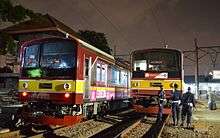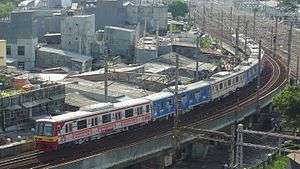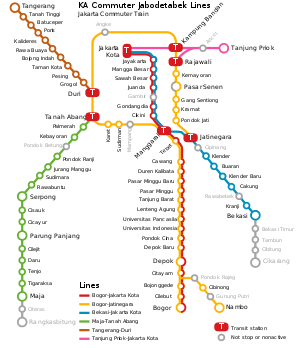KA Commuter Jabodetabek
 | |||
| Overview | |||
|---|---|---|---|
| Owner | PT Kereta Api Indonesia | ||
| Locale | Jabodetabek (Jakarta Metropolitan Area) | ||
| Transit type | Commuter rail | ||
| Number of lines | 6 | ||
| Number of stations | 82 (11 inactive) | ||
| Daily ridership | 737,030 (2015)[1] | ||
| Annual ridership | 253 million (2015)[2] | ||
| Website | http://www.krl.co.id/ | ||
| Operation | |||
| Began operation |
April 6, 1925 (as Dutch Colonial Railways or Staats Spoorwegen); 2000 (under PT Kereta Api, as "Jabotabek Division"); September 15, 2008 (under PT KCJ and current branding) | ||
| Operator(s) | PT KAI Commuter Jabodetabek (KCJ) | ||
| Train length | 4, 8, 10 or 12 cars per trainset | ||
| Headway | 5 - 15 minute(s) | ||
| Technical | |||
| System length | 235 km (146 mi) | ||
| Track gauge | 1,067 mm (3 ft 6 in) | ||
| Electrification | 1,500 V DC overhead catenary | ||
| Average speed | 50 km/h (30 mph) | ||
| Top speed | 70 km/h (45 mph) | ||
| |||
KA Commuter Jabodetabek, commonly known as Commuterline or KRL (Kereta Rel Listrik, Electric Multiple Unit) is a commuter rail system in the Jakarta metropolitan area, Indonesia. KA Commuter Jabodetabek is operated by KAI Commuter Jabodetabek (KCJ), a subsidiary of Kereta Api Indonesia, Indonesian national railway company. The infrastructure are owned by Kereta Api Indonesia and some of the stations and lines are used concurrently with regular intercity trains.
Jabodetabek refers to Jakarta metropolitan area, widely known as Jabodetabek. Jabodetabek itself is formed by combining the first syllables of Jakarta, Bogor, Depok, (Greater) Tangerang and Bekasi, which also represent KA Commuter's operational area. The current rolling stock are composed by used Japanese trains from Tokyo Metro, Toei Subway, Japan Railways and Tokyu, with some local-produced trains from Industri Kereta Api (INKA).
History
In 1923, before Indonesian declaration of independence, Staatsspoorwegen (SS), a Dutch colonial railways company, built the first electrified railway from Tanjung Priok to Meester Cornelis (Jatinegara) and began operation in 1925 with 3000-series locomotives from SLM–BBC (Swiss Locomotive and Machine Works - Brown Boveri & Cie), 3100-series electric locomotives from AEG Germany, 3200-series locomotives from Werkspoor Netherlands and passenger coaches from Westinghouse and General Electric. The electrification project continued in 1927 in an existing railway which served around Batavia and neighboring cities.
After independence in 1945, the railway operation was taken over by Djawatan Kereta Api Repoeblik Indonesia (Indonesian Railways Bureau, now PT Kereta Api). In 1976, the old locomotives and coaches were replaced with electric trains from Japan. The commuter system was started in 2000, integrating railway lines covered under PTKA's Division of First Operational Areas (Daop 1 Jakarta) and the said area was taken under its subsidiary, PT KAI Commuter Jabodetabek, in 2008.
The modernization of the commuter railway system was started in 2011 by greatly reducing the number of lines from 37 point-to-point routes to 6 integrated lines, removal of express services, and simplifying the classes into two service classes (Economy class or non-air conditioned train–subsidized by Ministry of Transportation, and Commuter class or air-conditioned train) which stops at every station. On July 25, 2013, the economy class discontinued, leaving the Commuter class as the sole service class throughout the network.[3]
Due to extreme crowding, unruly passengers (colloquially called Atappers) had been riding on top of the trains en masse, but that has since been brought under control with physical barriers. In July 2013, the operator introduced the Commet (Commuter Electronic Ticketing) system replacing the old paper ticket system and changing the old fare system into 'progressive fare' system, and the modernization of all 80 serving stations.
Starting on April 1, 2015, the number of trips per day was increased to 872, dominated by Bogor/Depok route and Bekasi route with 391 trips and 153 trips per day, respectively. Headway of Bogor route is 5 minutes, while Bekasi route is still 12 minutes.[4]
In July 2015, KA Commuter Jabodetabek served more than 850,000 passengers per day, which is almost triple of the 2011 figures, but still less than 3.5% of all Jabodetabek commutes.[5] It is predicted will serve 1.2 million passengers per day in 2019.[6]
Two expansion project are underway. Green Line (Tanah Abang - Maja) is being extended to Rangkasbitung, while Blue Line (Jakarta Kota - Bekasi) is being extended to Cikarang. Four new stations will be built in the Blue Line extension. Both project will electrify the existing regular rail tracks and are expected to be operational by late 2016.[7]
In addition to new stations in Blue Line extension, three other stations will be reactivated: one station on Pink Line (Ancol) and two stations on Yellow Line (Pondok Rajeg and Gunung Putri).[7]
Service routes
Since the modernization project in 2011, the system has seven integrated commuter lines which serve Greater Jakarta. The network route map recognised by color-coded and destination of final station.
| Lines | Services | No. of stations | Length | Operated |
|---|---|---|---|---|
| | Jakarta Kota to Depok | 20† | 33.3 km (20.7 mi) | 1930 |
| Jakarta Kota to Bogor | 24† | 54.8 km (34.1 mi) | 1930 | |
| | Jatinegara to Depok | 25^ | 47.222 km (29.342 mi) | 1987 |
| Jatinegara to Bogor | 29^ | 69.352 km (43.093 mi) | 1987 | |
| Duri to Nambo | 20 | 50.803 km (31.568 mi) | 2015 | |
| | Tanah Abang to Serpong | 8 | 55.629 km (34.566 mi) | 1992 |
| Tanah Abang to Parung Panjang | 11 | 24.278 km (15.086 mi) | 2009 | |
| Tanah Abang to Maja | 17 | 55.629 km (34.566 mi) | 2013 | |
| | Jakarta Kota to Bekasi | 18† | 27.4 km | 1992 |
| | Duri to Tangerang | 11 | 19.297 km (11.991 mi) | 1997 |
| | Jakarta Kota to Tanjung Priok | 4 | 15.373 km (9.552 mi) | 2015 |
| † excluding Gambir station, not serving Commuterline trains
^ excluding Angke station, not serving Commuterline trains | ||||
Stations
List of stations
Bold: Terminus or transit stations
Italic: Closed for Commuterline, open for intercity trains
Strikethrough: Closed for all services
† Some trains starts and terminates here |
|
† Some trains starts and terminates here ^ One early morning train (KA 1903) terminates here instead of Tanah Abang and one morning train (KA 1919) starts here instead of Serpong, Parungpanjang or Maja |
|
| | |
|---|---|
† Some trains starts and terminates here ^ For Northbound (to Depok/ Bogor) trains only. Southbound (to Jatinegara) trains does not stop here. | |
| |
List of major stations
Below are the list of main and terminus stations, some of them also servicing intercity train lines.
| Station | Lines | Establishment | Intercity/Local Station | Type |
|---|---|---|---|---|
| Jakarta Kota | 1926 | Yes | Commuter Terminus and Transit, and Local Terminus. | |
| Gambir | 1884 | Yes | Intercity Terminusa | |
| Manggarai | 1918 | Yes | Commuter main transit | |
| Jatinegara | 1910 | Yes | Commuter terminus, transit and East Westbound Intercity stopb | |
| Tanah Abang | 1910 | Yes | Commuter terminus and transit, West Intercity Terminus | |
| Duri | Yes | Commuter terminus and transit, Local stopc | ||
| Kampung Bandan | No | Commuter transit | ||
| Pasar Senen | 1925 | Yes | Intercity terminus, Westbound Local stop and Northbound Commuter stop d | |
| Bogor | 1881 | Yes | Commuter and South Local terminus (bogor Paledang station)b | |
| Bekasi | Yes | Commuter terminus, East Suburban transit and East Intercity transit (night-time only) |
- ^a Gambir Station doesn't serve as commuter stop, because of busy intercity train services in Gambir. Passengers who travel to areas near Merdeka Square, can depart in neighboring Gondangdia or Juanda station.
- ^b South Local trains (operated by PTKA, serving trips from Bogor to Sukabumi/Cianjur.) starts and ends from Bogor Paledang, within walking distance from Bogor station.
- ^c Duri Station is planned to be the transit for Airport Commuter Train, which will be under construction in 2014.
- ^d Pasar Senen station only serve the Jatinegara - Depok/Bogor commuter service, while the Bogor/Depok - Jatinegara service doesn't stop here.
New stations
On 17 April 2012, PT KAI Commuter Jabodetabek (KCJ) spokesman announced that the new stations will be built at:[8]
- Roxy (Central Jakarta)
- Matraman (East Jakarta)
- Tomang (West Jakarta)
- Bandengan (North Jakarta)
- Sukaresmi (Bogor)
KCJ will also refurbished old stations at:
- Mampang
Ticketing and fares
| (in IDR) | |
|---|---|
| First 25 kilometers | 3,000 |
| Every next 10 kilometers | 1,000 |
| Ticket deposit | 10,000 (refundable) |
| Accepted cards | COMMET BCA Flazz Mandiri e-money BNI TAPCASH BRIZZI |

Passengers may purchase ticket for single or multiple journeys. Single-journey cards (Tiket Harian Berjaminan/THB) may be purchased at any ticket counters or C-VIM vending machines, available in some stations. Rp 10,000 deposit will be levied on top of the fare to be paid. Passengers may recharge the card for the next trip, or refund the deposit at the ticket counter or vending machines in any Commuterline stations. However, if the card is not used or recharged for 7 days, the card will expire and the cannot be refunded.
Passengers may also purchase ticket for multiple journeys (Kartu Multi-trip/KMT). KMT is priced at Rp 50,000 (including Rp 30,000 credit).[9] The card has no expiry date and can be used with a minimum credit of Rp 11,000, based on the highest available fare in the system. The card may be topped-up at the ticket counters or vending machines.
In addition to KCJ-issued cards, passengers may also purchase bank-issued cards. Unlike KCJ-issued cards which may only be used for train fares and station's park-and-ride facilities, these cards may also be used for payment for goods and services at selected merchants, gas stations, TransJakarta BRT, selected parking facilities, and toll road payments. Currently Commuterline accepts Mandiri e-Money,[10] BRIZZI,[10] BNI TapCash,[10] and flazz BCA.[11]
Fares
Fare is charged by distance traveled ('progressive fare'), Rp 3,000 for the first 25 kilometers and IDR 1,000 for every the next 10 kilometers.[12] The fare is subsidized by the Ministry of Transportation. For 2016, the government allocated Rp 1.1 trillion public service obligation to Commuterline[13]
Prior to the introduction of distance-based fare, the fare is determined by number of stations passed. The first five stations passed is charged at Rp 3000 and every next three stations charged at Rp 1000. Between July and November 2013, the charges were lowered to Rp 2000 and Rp 500 respectively, after the government subsidized the fare.[14] Number of passengers increased by 30% after one week of introduction of the new fares.[15]
Rolling stock

Most of KRL Jabodetabek rolling stock are air-conditioned second-hand rail cars imported from Japan serving alongside a minority of domestically made air-conditioned cars made by Industri Kereta Api (INKA).
Train without air conditioning (mainly economy class) are no longer operated as KCJ (the operator) begins the single-service operation of air-conditioned for KRL Jabodetabek which means all train must be air-conditioned. One set of ex-economy class (Holec) has been retrofitted with air conditioning by INKA. Moreover, KAI (parent company of KCJ) stated that the economy class train are not feasible to use and the maintenance cost is high due to old age of train (some were made in 1976).
Trains are generally formed of 6 or 8 cars, with a capacity of 80–110 passengers per car. With the arrival of the ex-Japanese JR 205 series, PT. Kereta Api Indonesia will begin operation of 10-cars-consisted trainset.
Most KRL Ekonomi will be scrapped, but some will be preserved if there is a plan to preserve the first modern EMU in Indonesia.
The Toei 6000 series was the first air-conditioned train type to be scrapped in December 2015 due to a large number of newer secondhand 205 series trains displacing the aging 6000 series trains.[16]
Since 1 January 2016, the ex-JR East 103 series have been retired.
Non-air conditioned rolling stock
All retired have been since 2013.
- KRL Ekonomi BN-Holec (retired, some modified to become diesel commuter trains)
- KRL Ekonomi Rheostat (KL3 series, scrapped or stored)
- KRL Hitachi (scrapped or stored)
- KRL ABB Hyundai (retired, some modified to become diesel commuter trains)
Air conditioned rolling stock

- 103 series (ex-JNR/JR rolling stock, retired in January 2016)
- 203 series (ex-JNR/JR rolling stock)
- 205 series (ex-JNR/JR rolling stock)
- Toei 6000 series (ex-Toei Mita Line rolling stock, retired in October 2016)
- Tokyu 8000 series (ex-Tokyu rolling stock)
- Tokyu 8500 series (ex-Tokyu rolling stock)
- Tōyō Rapid 1000 series (ex-Tōyō Rapid Railway rolling stock)
- Tokyo Metro 05 series (ex-Tokyo Metro Tōzai Line rolling stock)
- Tokyo Metro 5000 series (ex-Tokyo Metro Tōzai Line rolling stock)
- Tokyo Metro 6000 series (ex-Tokyo Metro Chiyoda Line rolling stock)
- Tokyo Metro 7000 series (ex-Tokyo Metro Yūrakuchō Line rolling stock)
- KRLI (INKA, retired in 2015)
- KRL i9000 (INKA in cooperation with Bombardier with financing by KfW)
- KRL Holec AC (former KRL Ekonomi Holec trains retrofitted with AC from 1994–2001, currently suspended)
 103 series
103 series 203 series
203 series 205 series
205 series 6000 series (former Toei Mita Line)
6000 series (former Toei Mita Line) 8000 series
8000 series 8500 series
8500 series 1000 series
1000 series 05 series
05 series 5000 series
5000 series 6000 series (former Tokyo Metro Chiyoda Line)
6000 series (former Tokyo Metro Chiyoda Line) 7000 series
7000 series KRL i9000
KRL i9000
Incidents and accidents
- 23 September 2015 – A collision between two electric trains (KRL 1154 and KRL 1156) at Juanda Station [17]
- 9 December 2013 – A collision of KRL Serpong-Jakarta with Pertamina tanker truck at the Bintaro Permai intersection, Tangerang.[18][19]
- 20 May 1999 – Indonesia University student killed by the KRL in Pondok Cina.[20]
 Former Kawagoe set 15 after re-organization with former Kawagoe set 32 in Serpong Station, 2015. Both sets were involved in the 2015 Juanda accident.
Former Kawagoe set 15 after re-organization with former Kawagoe set 32 in Serpong Station, 2015. Both sets were involved in the 2015 Juanda accident. Car 7021 sits in Cikaum station. The set was involved in the 2013 Bintaro accident.
Car 7021 sits in Cikaum station. The set was involved in the 2013 Bintaro accident.
See also
References
- ↑ "Malas Kena Macet, Jumlah Penumpang KRL Naik 24,6 Persen".
- ↑ "Malas Kena Macet, Jumlah Penumpang KRL Naik 24,6 Persen".
- ↑ Syailendra. "KRL Ekonomi Non-AC Dihapus Sejak Hari Ini". Tempo.co. Retrieved 13 March 2014.
- ↑ "Penambahan Jadwal Commuter Line dan Ancaman Kemacetan". March 27, 2015.
- ↑ "PT KCJ: Keterlambatan KRL Sudah di Bawah 10 Menit". July 6, 2015.
- ↑ Agustin Setyo Wardani (February 3, 2015). "2014, Sebanyak 200 Juta Orang Naik Kereta Jabodetabek".
- 1 2 "KRL Commuter Line Ditargetkan Beroperasi hingga Cikarang dan Rangkasbitung pada 2016". Kompas.com (in Indonesian). 28 December 2015.
- ↑ "5 new stations to be built for commuter trains". April 17, 2012.
- ↑ http://www.thejakartapost.com/news/2013/07/01/commuters-welcome-kcj-s-cheaper-train-fares.html
- 1 2 3 "Naik KRL Sekarang Bisa Pakai Tiga Kartu Prabayar Bank BUMN". June 16, 2014.
- ↑ Administrator. "Kartu Flazz BCA Kini Dapat Digunakan Untuk Transaksi Perjalanan KRL | BERITA TERKINI". www.krl.co.id. Retrieved 2016-04-12.
- ↑ "Mulai 1 Oktober, Tarif KRL Jabodetabek Naik". Retrieved October 13, 2016.
- ↑ "Pemerintah Beri Subsidi Kereta Rp 1,8 T di 2016, Rp 1,1 T Untuk KRL". detikfinance. Retrieved 2016-04-12.
- ↑ http://www.thejakartapost.com/news/2013/06/27/cheaper-train-fares-and-e-tickets-kcj.html
- ↑ "Train commuters up by 30 percent". July 8, 2013.
- ↑ http://krl-jabodetabek02.cocolog-nifty.com/blog/2015/11/6000depok-4d3f.html
- ↑ KRL collision in Juanda station.
- ↑ Seven people killed in accident collision of a tanker truck vs KRL
- ↑ KRL collision fatalities and increased tanker truck
- ↑ Indonesia University student killed by the KRL in Pondok Cina
External links
![]() Media related to KRL Jabotabek at Wikimedia Commons
Media related to KRL Jabotabek at Wikimedia Commons
- KRL Jabotabek website (Indonesian)
- Jabotabek Railnews (Japanese)
- KRL Jabodetabek (Japanese)
- KRL-Mania - KRL Jabotabek community site (Indonesian)
